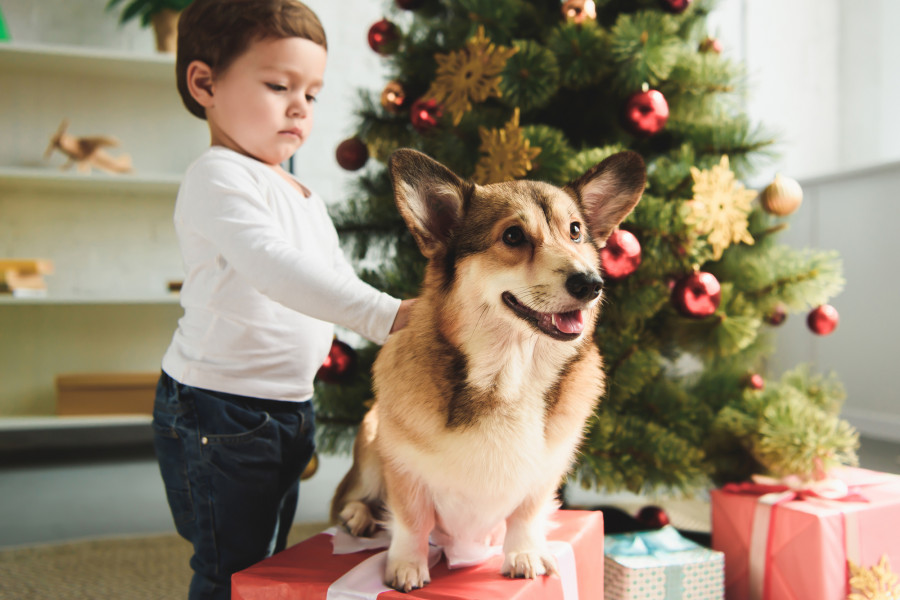Teaching Children How to Act Around Dogs: Dos and Don’ts for Safe Interactions

Kids love dogs. Maybe more than ice cream. You can see the excitement on their face when they see one on a walk or on a car ride. “Doggie” is often one of the first words a child learns. But this excitement along with lack of knowledge can spell trouble if your child rushes towards a dog without thinking. While it’s wonderful for children to be around dogs, it’s important to teach them how to interact with them. Kids will learn empathy and respect of another being and it will help reduce the chance that your child gets bitten. Here are some dos and don’ts for safe interactions between children and dogs.
NOTE: Using a stuffed dog is a great way to teach your child these important safety dos and don’ts, before interacting with a real dog.
Dos
Do ask before approaching a strange dog. Even if they “look” friendly. Remember that a wagging tail DOES NOT always mean the dog is happy or relaxed. It can also be a sign of stress or arousal.
Do ask before petting. Some dogs are fine with the approach of a stranger, but prefer to not be touched. It’s always good to ask before approaching and then again before petting.
Do approach any dog slowly, at a walk.
Do keep your face and hands away from the dog’s face. Teach your child to pet a dog on the neck, or back, instead of on the head or muzzle. A lot of dogs do not like people in their face and it can cause them to get stressed.
Do talk softly to the dog. Remember they have much better hearing than we do and prefer quiet words.
Do let sleeping dogs lay. This can be hard for some kids, but it’s best to teach your child that if a dog is sleeping, to let it sleep. Getting startled awake by a child may cause the dog to snap or bite.
Do learn dog body language. There are free posters you can download online that help with this one. It’s good for a child to recognize when a dog is nervous or stressed. Teach your child to back away slowly if a dog seems to be uncomfortable.
Do keep an eye on the dog. Teach kids to be aware of where the dog is when interacting with them. This is important for several reasons. For example, little dogs may get stepped on or bigger dogs may knock your child over.
Don’ts
Don’t approach a dog from behind, this can startle them. A startled dog may snap or bite.
Don’t grab their fur. Explain to children that pulling on a dog’s hair is the same as if someone pulled on their hair. It HURTS! A dog that feels pain is more likely to snap or bite.
Don’t pat the dog. Most dogs prefer a good scratch or a stroke. And some kids can’t control how hard they pat, which to the dog may feel more like hitting. It’s safer to teach them to stroke or scratch.
Don’t hug dogs. While most humans love hugs, dogs do not. Instead show your love with a nice stroke or scratch.
Don’t scream or raise your voice. This can scare some dogs, causing them to try and run. If they are in a situation where they can’t run away, they may bite.
Don’t wave your arms around wildly. Sometimes a child can get excited and may want to run around or wave their arms wildly. This can set off prey drive in some dogs, who may see your child as a fun toy to play with in a not so fun way.
Don’t run away from a dog. Running, like screaming and hand waving, can cause a dog’s prey instincts to kick in.
Don’t eat around the dog. Most dogs are greedy thieves and children are at a perfect height to steal a snack from…and the dog may accidentally get fingers too.
Don’t pull on the tail…or ears…or any other body part. Explain to your child how that can hurt the dog. Remember, a dog in pain is more likely to bite!
Don’t bother your dog while he is eating. It’s best to teach kids to not stick their hands in your dog’s food bowl, or to bother them, while they are eating.
Don’t try and take their toys from them. While we all know sharing is good, this is one of those times where you will have to teach your child that if the dog has something, it’s “his” and should not be taken away. Some dogs can get very cranky if you try and take what they have.
After learning these dos and don’ts its important to watch children while they are around dogs, especially new dogs. If your children have learned the rules and are you are watchful, everyone will have a pleasant and safe experience.

I have enjoyed your tips on dogs at the moment I have a maltese kelpie x and an German Shepard both big dogs are rescue dogs both very possessive Shepard is very dominant this is his third home .I am hoping I can do that for him as he has separation problems. I always took my kelpie and little dog with me but it's to hard to take all 3 dogs so I have started leaving my kelpie home to baby sit Shepard. But I think it may be upsetting my kelpie as she is always with me in can.now she not .what do you think I should do .they do play great together. Is it just me feel bad because I feel like I have let kelpie down .would like to hear what you think